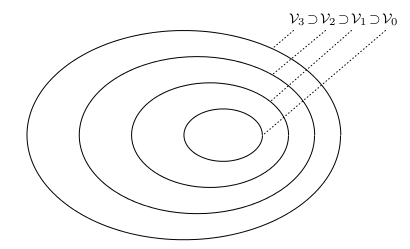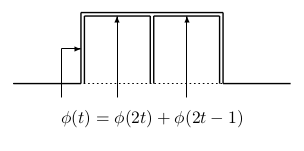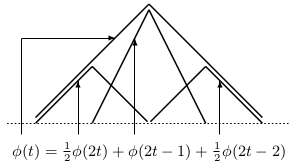| << Chapter < Page | Chapter >> Page > |

where the coefficients are a sequence of real or perhaps complex numbers called the scaling function coefficients (or the scaling filter orthe scaling vector) and the maintains the norm of the scaling function with the scale of two.
This recursive equation is fundamental to the theory of the scaling functions and is, in some ways, analogous to adifferential equation with coefficients and solution that may or may not exist or be unique. The equation is referred to by different names to describe different interpretations or points of view.It is called the refinement equation, the multiresolution analysis (MRA) equation, or thedilation equation.
The Haar scaling function is the simple unit-width, unit-height pulse function shown in [link] , and it is obvious that can be used to construct by
which means [link] is satisfied for coefficients .
The triangle scaling function (also a first order spline) in [link] satisfies [link] for and the Daubechies scaling function shown in the first part of


Figure: Daubechies Scaling Functions satisfies [link] for as do all scaling functions for their corresponding scaling coefficients. Indeed, the design ofwavelet systems is the choosing of the coefficients and that is developed later.
The important features of a signal can better be described or parameterized, not by using and increasing to increase the size of the subspace spanned by the scaling functions, but bydefining a slightly different set of functions that span the differences between the spaces spanned by the various scales of the scaling function. These functions are the waveletsdiscussed in the introduction of this book.
There are several advantages to requiring that the scaling functions and wavelets be orthogonal. Orthogonal basis functions allow simple calculationof expansion coefficients and have a Parseval's theorem that allows a partitioning of the signal energy in the wavelet transform domain.The orthogonal complement of in is defined as . This means that all members of are orthogonal to all members of . We require
for all appropriate .
The relationship of the various subspaces can be seen from the following expressions. From [link] we see that we may start at any , say at , and write
We now define the wavelet spanned subspace such that
which extends to
In general this gives
when is the initial space spanned by the scaling function . [link] pictorially shows the nesting of the scaling function spaces for different scales and how the wavelet spaces are the disjoint differences (except for the zero element)or, the orthogonal complements.
The scale of the initial space is arbitrary and could be chosen at a higher resolution of, say, to give
or at a lower resolution such as to give

Notification Switch
Would you like to follow the 'Wavelets and wavelet transforms' conversation and receive update notifications?